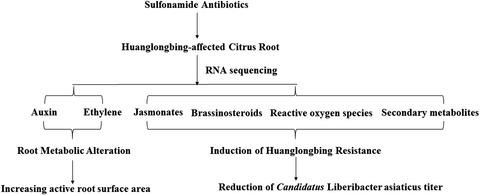当前位置:
X-MOL 学术
›
Plant Pathol.
›
论文详情
Our official English website, www.x-mol.net, welcomes your feedback! (Note: you will need to create a separate account there.)
Transcriptomic Analysis Reveals Root Metabolic Alteration and Induction of Huanglongbing Resistance by Sulfonamide Antibiotics in Huanglongbing‐affected Citrus Plants
Plant Pathology ( IF 2.7 ) Pub Date : 2020-05-01 , DOI: 10.1111/ppa.13154 Chuanyu Yang 1, 2, 3 , Charles A. Powell 2 , Yongping Duan 4 , Veronica Ancona 3 , Junyuan Huang 1 , Muqing Zhang 1, 2, 4
Plant Pathology ( IF 2.7 ) Pub Date : 2020-05-01 , DOI: 10.1111/ppa.13154 Chuanyu Yang 1, 2, 3 , Charles A. Powell 2 , Yongping Duan 4 , Veronica Ancona 3 , Junyuan Huang 1 , Muqing Zhang 1, 2, 4
Affiliation

|
Huanglongbing (HLB) is a devastating disease that affects the entire citrus plant, including the root system. Previous studies have shown that sulphonamide antibiotics can suppress titres of the pathogen that causes HLB, ‘Candidatus Liberibacter asiaticus’ (CLas), and affect root morphology in the plant through unknown mechanisms. To better understand the response of CLas‐infected roots to sulphonamide antibiotics, hydroponic cultures of CLas‐infected citrus roots were treated with sulfadimethoxine sodium (SDX), indole butyric acid (IBA), or water for 60 days to evaluate root metabolism and resistance against CLas via transcriptomic analysis. This study indicated that SDX and IBA treatments increased active root surface area in HLB‐affected citrus, which may be due to root hair and lateral root growth. CLas titres in HLB‐affected citrus roots treated with SDX were lower than those of IBA and control treatments. Function categorization indicated that plant hormone signal transduction and plant–pathogen interaction were the most markedly enriched pathways in the HLB‐affected citrus root after SDX treatment. The expression of genes involved in biosynthesis of auxin and ethylene, which are related to root hair and lateral root growth, were up‐regulated by SDX. Moreover, SDX also induced genes related to the metabolism of jasmonates, brassinosteroids, reactive oxygen species, and secondary metabolites, which are beneficial for resistance against HLB. In conclusion, we propose a model for SDX in regulating metabolic pathways in the root and resistance against CLas in HLB‐affected citrus root, which is beneficial for recovering an HLB‐affected citrus root system and combating CLas.
中文翻译:

转录组学分析揭示了磺胺类抗生素对受黄龙病影响的柑橘植物的根代谢改变和黄龙病抗性的诱导
黄龙病(HLB)是一种破坏性病害,影响整个柑橘植物,包括根系。先前的研究表明,磺胺类抗生素可以抑制导致 HLB 的病原体“亚洲利氏假丝酵母菌”(CLas)的滴度,并通过未知机制影响植物的根系形态。为了更好地了解 CLas 感染的根对磺胺类抗生素的反应,用磺胺二甲氧嘧啶钠 (SDX)、吲哚丁酸 (IBA) 或水处理 CLas 感染的柑橘根的水培培养物 60 天,以评估根的代谢和抗性CLas 通过转录组学分析。该研究表明,SDX 和 IBA 处理增加了受 HLB 影响的柑橘的活跃根表面积,这可能是由于根毛和侧根生长。用 SDX 处理的受 HLB 影响的柑橘根中的 Clas 滴度低于 IBA 和对照处理。功能分类表明植物激素信号转导和植物-病原体相互作用是 SDX 处理后受 HLB 影响的柑橘根中最显着富集的途径。SDX上调了与根毛和侧根生长相关的生长素和乙烯生物合成相关基因的表达。此外,SDX 还诱导与茉莉酸、油菜素内酯、活性氧和次级代谢产物代谢相关的基因,这些基因有利于对 HLB 的抗性。总之,我们提出了一种 SDX 模型,用于调节根中的代谢途径和受 HLB 影响的柑橘根中对 CLas 的抗性,
更新日期:2020-05-01
中文翻译:

转录组学分析揭示了磺胺类抗生素对受黄龙病影响的柑橘植物的根代谢改变和黄龙病抗性的诱导
黄龙病(HLB)是一种破坏性病害,影响整个柑橘植物,包括根系。先前的研究表明,磺胺类抗生素可以抑制导致 HLB 的病原体“亚洲利氏假丝酵母菌”(CLas)的滴度,并通过未知机制影响植物的根系形态。为了更好地了解 CLas 感染的根对磺胺类抗生素的反应,用磺胺二甲氧嘧啶钠 (SDX)、吲哚丁酸 (IBA) 或水处理 CLas 感染的柑橘根的水培培养物 60 天,以评估根的代谢和抗性CLas 通过转录组学分析。该研究表明,SDX 和 IBA 处理增加了受 HLB 影响的柑橘的活跃根表面积,这可能是由于根毛和侧根生长。用 SDX 处理的受 HLB 影响的柑橘根中的 Clas 滴度低于 IBA 和对照处理。功能分类表明植物激素信号转导和植物-病原体相互作用是 SDX 处理后受 HLB 影响的柑橘根中最显着富集的途径。SDX上调了与根毛和侧根生长相关的生长素和乙烯生物合成相关基因的表达。此外,SDX 还诱导与茉莉酸、油菜素内酯、活性氧和次级代谢产物代谢相关的基因,这些基因有利于对 HLB 的抗性。总之,我们提出了一种 SDX 模型,用于调节根中的代谢途径和受 HLB 影响的柑橘根中对 CLas 的抗性,

























 京公网安备 11010802027423号
京公网安备 11010802027423号